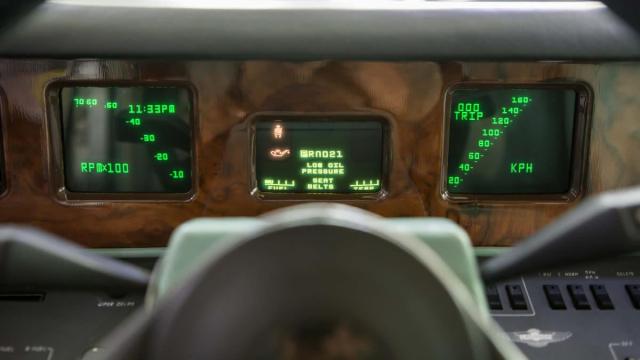When it debuted in 1976, the Aston Martin Lagona was one of the most expensive, technologically advanced, ambitious cars ever made. So why was it getting built by hand by a bunch of old guys in what looked more like a shed than a factory?
At a whopping £50,000 pounds in 1976, or just over $383,000 dollars today, the Lagonda was meant to be the sedan for the elite. It had space-age design, plush leather seating, wood details inside, and of course its industry-first digital dashboard.
What kind of car company was making this super luxury mobile? One that had been very recently bankrupt, and had only just restarted its old-school factory.
This was very early days for compact computing in general, let alone getting digital instruments crammed inside a car’s dashboard, using CRT projectors like your old TV. As my colleague Jason Torchinsky wrote a few years back, while wondering if he could make a Lagonda dash in his basement:
And, the computer that drove the CRTs was fascinating as well. This is long before standardised, small computers like the one in your pocket that could be stuck in a dash — everything here was custom-made.
From what I’ve found, the computer was based on the popular Z80 CPU. Most of us know this chip better as the heart of Pac-Man arcade machines, Game Boys, and business computers that ran an OS called CP/M. Even better, everything about this computer seems to have been delightfully slipshod.
Amazingly, the CRT system was the improvement over the early production Lagondas, which were in turn a serious step up from the pro-production Lagondas, which had something around 40 touch-sensitive buttons. Those didn’t work. Hemmings explained that Aston really wasn’t capable of developing groundbreaking tech on its own, nor did it have perhaps the best judgement (or finances) for picking a qualified partner:
The job of designing the new digital system was entrusted to graduate students at the Cranfield Institute of Technology, which turned out to be an unfortunate decision. When, after months of hurried development work, a running Lagonda was finally shown to the press in the spring of 1978, smoke began to waft out of the dashboard, forcing red-faced executives to push the car. Aston Martin lost no time in looking for help. New director Peter Sprague, who was also chairman of National Semiconductor, called Lane Research in California, who in turn referred him to the Javalina Corporation, an aircraft instrument specialist in Frisco, Texas. Which is how, a few weeks later, the world’s only running Aston Martin Lagonda landed in the Lone Star State.
“The whole system was pretty much a nightmare,” recalled Brian Refoy, the president of Javalina. “The electronics package that Cranfield came up with weighed about 180 pounds. It had a 300-pair cable going from the instrument cluster to the rear seating compartment, where there were computer storage boxes under the rear seats.” Refoy and his team tossed everything and started from scratch. Within 45 days, they had the car on the road for testing; within 90 days, Aston Martin was delivering Lagondas to their new owners, some of whom had been waiting as long as two years. In the interim, the price had doubled to the equivalent of $US110,000 ($172,874), or about $US200,000 ($314,317) in today’s dollars.
The car itself also had some very strange features, as described by my colleague Justin Westbrook:
The Lagonda had two fuel doors, mounted on either side of the car in the c-pillar, but only one fuel tank. It also had two different horns, the fusebox was located in the middle of the dashboard where you might expect the radio to be, the parking brake is between the driver’s seat and door, and the only odometer readout is under the front-hinged hood.
As Doug points out, the back doors didn’t open very wide and the rear seating room was more cramped than you’d expect, despite this car being nearly four feet longer than the VW Golf of the time. The rear-passenger air vents are mounted behind the passengers’ heads, and the taillights open with the trunk so there’s no way for cars to see you stopped on the side of the road at night.
Amazingly, the car sold surprisingly well for an Aston, particularly in the new-money Middle East, as noted in David Dowsey’s book Aston Martin: Power, Beauty, Soul. (The book also notes that developing the electronics delayed production of the Lagonda by two whole years.)
The ridiculous layout and completely novel features were practically worth the money right there. Watch the video above to see what else made the Aston Martin Lagonda truly a wonder to behold.
